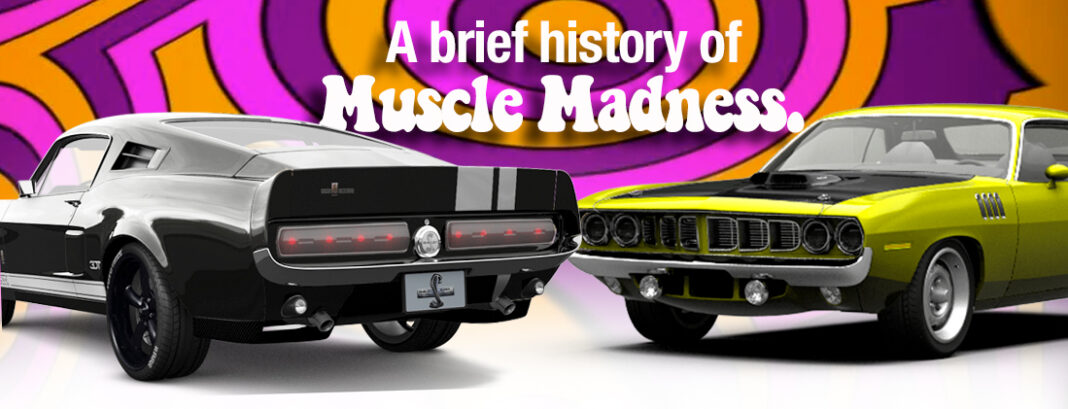It’s Been A Great Run For The High-Octane Muscle Cars That Once Roamed The Earth. A Look Back.
The American muscle car movement began in the late 1950s and early 1960s, as automakers sought to capitalize on the growing popularity of high-performance vehicles. The first true muscle car was the Pontiac GTO, introduced in 1964, followed by other iconic models like the Ford Mustang, Chevrolet Camaro, and Dodge Charger and Challenger.
During the late 1960s and early 1970s, the muscle car movement reached its peak, with automakers offering a range of powerful engines, distinctive styling, and advanced technology. These cars were designed for straight-line performance and were often used for drag racing and other high-speed events.
However, the muscle car movement faced several challenges during the 1970s, including the rising cost of gasoline, increased government regulation, and changing consumer preferences. As a result, many muscle cars were discontinued, and the market for high-performance vehicles declined.
In the late 1980s and early 1990s, there was a resurgence in the popularity of muscle cars, as automakers began to introduce new models and performance packages. Since then, the muscle car has become a staple of American automotive culture, with classic models like the Pontiac GTO, Ford Mustang, Chevrolet Camaro, and Dodge Charger and Challenger enjoying a dedicated following of enthusiasts.
Today, the American muscle car is a symbol of American automotive heritage, known for its distinctive style, powerful engines, and overall performance. Whether on the street or the track, these iconic vehicles continue to evoke a sense of excitement and passion, capturing the spirit of a bygone era in American automotive history.
The Pontiac GTO: The First “Muscle” Car
The Pontiac GTO is often considered to be one of the first muscle cars, but it is not universally recognized as the first muscle car. The term “muscle car” was not in widespread use at the time of the GTO’s introduction in 1964, but it is now often associated with this type of vehicle.
The GTO was one of the first cars to combine a big engine in a compact body, and it set the standard for what would become the muscle car segment. It was designed to appeal to younger, performance-oriented buyers who wanted a car that could go fast and look good doing it. The GTO was a hit and helped launch the muscle car craze of the 1960s, but it was not the first car to fit the description of a muscle car.
Several other vehicles, such as the Oldsmobile 4-4-2 and the Buick Skylark Gran Sport, preceded the GTO and could also be considered early examples of muscle cars. However, the GTO is widely recognized as a trailblazer in the muscle car segment and is often credited with popularizing the concept.
The Forgotten AMC Javelin’s V8 Muscle
The AMC Javelin was produced by the American Motors Corporation (AMC) from 1968 to 1974. It was designed to be a compact, sporty car that could compete with other muscle cars of the time such as the Ford Mustang and Chevrolet Camaro.
The first generation of the Javelin was produced from 1968 to 1970 and was offered with a variety of engines, including a 290 cubic inch V8 and a 343 cubic inch V8. These early models were well-received by enthusiasts and helped establish the Javelin as a player in the muscle car market. In 1971, the Javelin received a facelift and a new engine option, the 360 cubic inch V8. The car also gained wider popularity thanks to its use in motorsports, where it won several races and was even driven by famous race car driver Mark Donohue.
By the mid-70s, however, the muscle car market was starting to decline due to changing consumer preferences and increasing government regulations. The Javelin was updated for the 1974 model year with new safety and emissions standards, but sales were still sluggish and production ended in 1974. Despite its relatively short lifespan, the AMC Javelin remains an important part of muscle car history and continues to be a popular collector’s item among enthusiasts.
The Mercury Cougar Move
The Mercury Cougar was a car produced by the Mercury division of Ford Motor Company from 1967 to 2002. It started as a pony car, similar to the Ford Mustang, and went through several generations with different design styles and powertrains. In the 1970s and 1980s, the Cougar became a personal luxury car and later became a sport compact car in the 1990s. The car was discontinued in 2002 due to declining sales and shifting market trends. Despite its discontinuation, the Mercury Cougar has a dedicated fanbase and is remembered as a significant part of Ford’s history.
The Lincoln-Mercury division also wanted a slice of the muscle-car pie from the beginning. At that time, Ford was not sure if the Mustang was even going to make it, let alone make it big. So all plans for the Cougar were put on hold till it was clear that the Mustang was going to be an unprecedented success. Funnily enough, till just before the launch, the Ford Mustang was going to be named the Ford Cougar.
The Cougar was far more refined than the Mustang – with a three-inch longer wheelbase adding much-needed inches to the rear legroom. The suspension was better and there was added sound insulation as well, making the Cougar a much smoother and a more hushed ride than the Mustang. The 1967 XR-7 model came with a top trim that had leather-trimmed seats, fake walnut-wood cabin accents as well and a cockpit-like overhead console. 151,000 of these were made that year, putting the Cougar third in sales, behind only the Ford Mustang and the Chevrolet Camaro.
The fiercest Cougar of them all was the 1968 GT-E. Priced at around $4,300 then, which cost an additional $1,311 over and above the base price of the Cougar, it was one powerful beast. For this package, the Cougar got the big boy of all engines that no Mustang ever got. 357 of 1968 Mercury Cougar GT-E got the 7.0-liter Big-Block V8, that spewed a massive 390 horsepower. Another 37 got the 428 Cobra Jet with or without Ram Air as an option, though this was lower in ponies than the Ford V8 option. Surprisingly, the Cougar demand seemed to be falling in 68, despite these two awesome power-loaded versions.
Plymouth’s Awesome Roadrunner and Barracuda
The Iconic Dodge Muscle
The Dodge Charger was first introduced in 1966 as a two-door fastback with a sleek, sporty design. During the late 1960s and early 1970s, the Charger became synonymous with the muscle car movement, offering powerful engines and distinctive styling. In the 1970s, the Charger shifted its focus to a more luxury-oriented market, with a more sophisticated design and higher-end features. However, sales of the Charger began to decline, and it was eventually discontinued in the late 1970s.
The Charger was reintroduced in the early 2000s, this time as a four-door sedan, and it quickly became one of Dodge’s most popular models. Over the years, the Charger has continued to evolve, with new engine options, advanced technology, and improved performance. Today, the Charger is widely regarded as one of the most iconic American muscle cars, known for its distinctive style, powerful engines, and overall performance.
The Dodge Challenger, on the other hand, was first introduced in 1970 as a response to the growing popularity of muscle cars. The Challenger was designed to compete with the Ford Mustang and Chevrolet Camaro, and it quickly became one of the most recognizable muscle cars of its time. However, the Challenger was only produced for a few years, and it was discontinued in 1974.
In 1978, the Challenger was reintroduced, but it was only produced for a few more years before being discontinued once again in 1983. The Challenger was not seen again until 2008, when Dodge reintroduced the iconic muscle car, this time with a focus on modern performance and technology. Since then, the Challenger has become one of Dodge’s most popular models, offering a range of engine options, advanced technology, and improved performance. Today, the Challenger is widely regarded as one of the most iconic American muscle cars, known for its distinctive style, powerful engines, and overall performance.
The Ford Mustang And Muscle History
The Ford Mustang is an American automobile that was first introduced on April 17, 1964, and has since undergone several design changes and updates. The original Mustang was a compact car, based on the Ford Falcon, and was marketed as a sporty, affordable option for younger buyers. It was an instant success, with 22,000 sold on the first day of its launch. Over the years, the Mustang has become larger and more luxurious, evolving into a muscle car and a cultural icon.
In the late 1960s, the Mustang received a more powerful engine and a redesigned body, becoming a true muscle car. During the 1970s, however, the Mustang faced declining sales and a shift towards smaller, more fuel-efficient cars. In response, Ford introduced smaller Mustang models and various special editions, including the Mustang II.
The fifth-generation Mustang was introduced in 1994, returning to its roots as a compact, sporty car. In 2005, the Mustang underwent a major redesign, featuring a retro-inspired body style that paid homage to the original Mustang design. This design has since been updated and refined, with the current generation Mustang offering a range of engine options, including a turbocharged four-cylinder and a V8.
The Mustang has been a cultural phenomenon since its introduction, appearing in numerous movies, TV shows, and video games, and inspiring countless merchandise, including clothing and toys. Today, the Ford Mustang remains one of the most recognizable and beloved cars in the world, with a loyal fan base and a rich history that continues to evolve.
The Camaro Takes On The Pack
First off, the bottom line: While the numbers say the Camaro has a big advantage in the engine department, the edge doesn’t look quite as large when you take vehicle weight into account, as the Camaro is about 300 pounds heavier than the Mustang. Even so, muscle cars are all about power, and the more the better. But the Camaro’s design has evolved nicely over time into a properly aggressive style, the Mustang still takes the cake in our book. The Camaro is a bit more compact than the Mustang, especially in terms of width and height, which might be an advantage in terms of parking and maneuverability.
Wait A Minute, What About The Corvette?
Interestingly, the Chevrolet Corvette is not considered a muscle car because it has a different design philosophy and market positioning compared to traditional muscle cars. Muscle cars are defined by their focus on straight-line acceleration and horsepower, as well as their bold and aggressive styling. The Corvette, on the other hand, is a sports car that has always placed a greater emphasis on balanced performance, including handling, braking, and acceleration, as well as speed. Additionally, the Corvette has a longer history and a more premium image than most muscle cars, and it has traditionally been positioned as a halo car for Chevrolet rather than as a muscle car.
So, while the Corvette has certainly been a high-performance car throughout its history, with powerful engines and impressive acceleration, it is not considered a muscle car because it has always had a different focus and image compared to traditional muscle cars. Instead, it is considered a classic sports car that has set the standard for American performance cars for over six decades.
And Let’s Not Forget The Pontiac Firebird
The Cougar nameplate stayed on for a good 30 years from 1967 to 1997 after which it was briefly retired. It re-emerged in 1999 but could stay afloat only till 2002 simply because they declawed this cat into an ordinary passenger car no one wanted. The highest selling year of the Cougar is 1978 with 213,000 plus cars having left the dealers with happy owners. But in the classic car bazaar, the first three years are the magic ones.
So What Muscle Car Is The G.O.A.T.?
The best muscle car is subjective and depends on personal preferences such as performance, design, and features. However, some of the most popular and highly regarded muscle cars include the:
- Chevrolet Camaro
- Ford Mustang
- Dodge Charger and Challenger
- Pontiac Firebird
These vehicles have become synonymous with the muscle car genre and have earned a place in automotive history for their distinctive style and powerful engines. Ultimately, the best muscle car for an individual will depend on their specific needs and desires, and can only be determined by considering factors such as budget, driving habits, and personal taste.







![[Presentation] Livestream of TMC’s Press Conference](https://www.miamicars.com/wp-content/uploads/2023/02/tmb_corporate-218x150.png)








